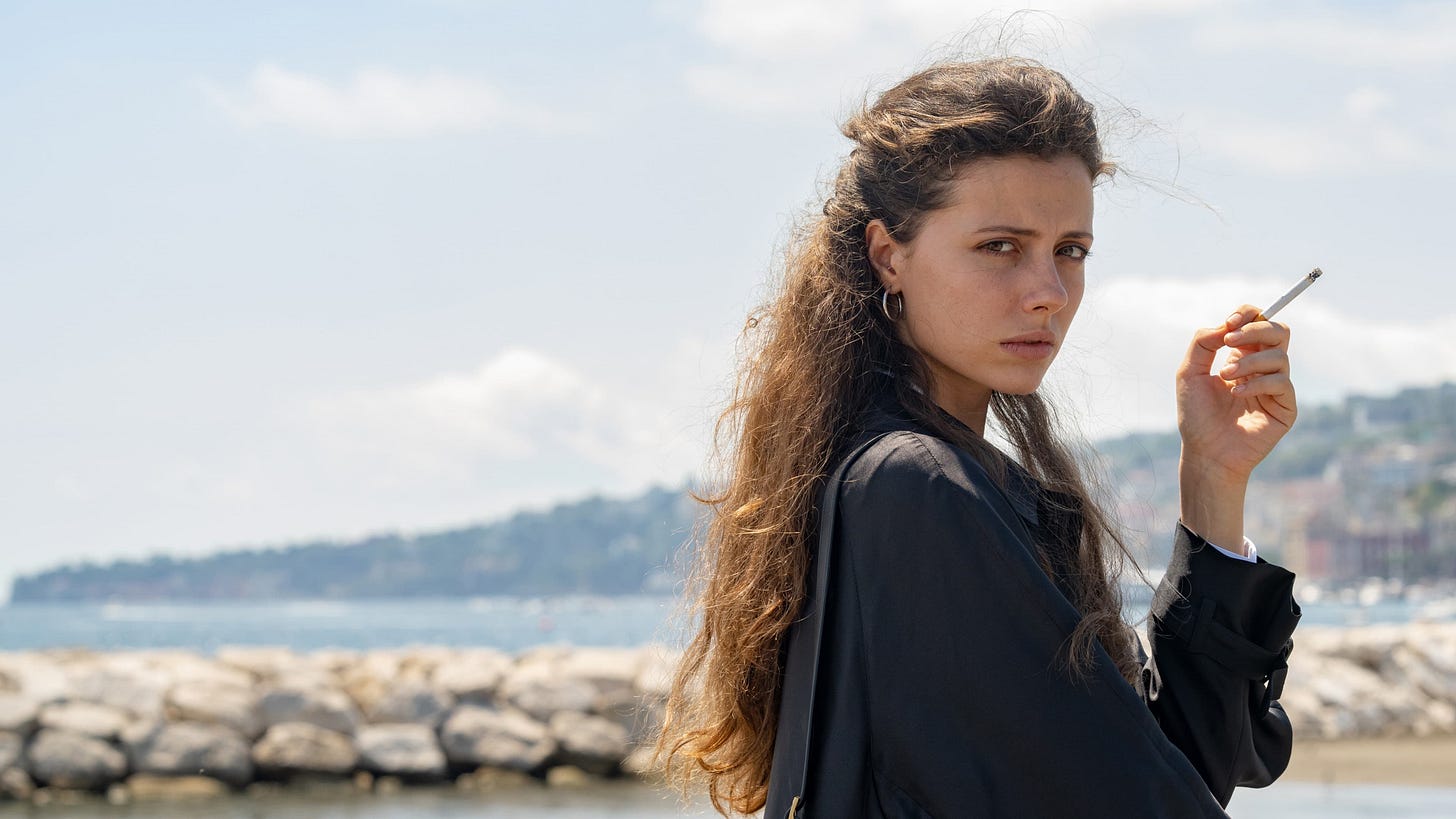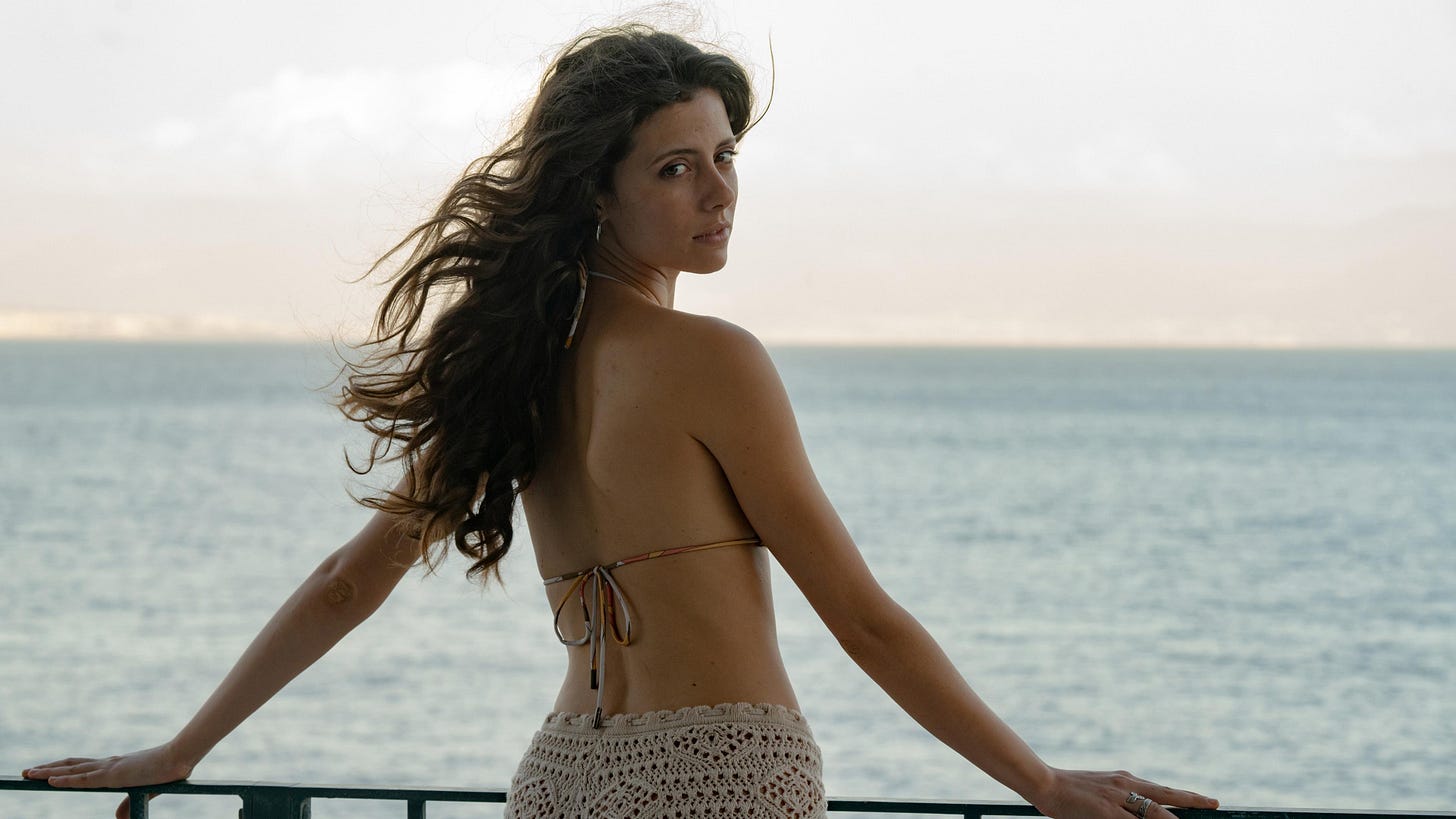Mesmo em trabalhos irregulares, como este Parthenope, o diretor e roteirista italiano Paolo Sorrentino (de A Grande Beleza, A Mão de Deus e A Juventude) acessa facilmente minhas emoções com a sua poesia cinematográfica. Os seus filmes são um convite a renunciar o tempo contemporâneo, em favor de uma experiência de contemplação em que o tempo parece estar suspenso. E, a partir da epopeia da personagem-título, uma mulher de beleza e sabedoria inigualáveis, Sorrentino pôde materializar o seu debate sobre contemplação erótica que Laura Mulvey tinha discutido no ensaio Prazer Visual e Cinema Narrativo. Enquanto questiona, transversalmente, os homens, e ele próprio, que parecem devorar a personagem-título com os olhos.
Parthenope resgata o tema da obra do diretor sobre beleza, juventude e nostalgia, em que a personagem interpretada por Celeste Dalla Porta manifesta-se como uma sereia da mitologia grega, com o dom de encantar as pessoas ao redor à sua vontade pela sua beleza inigualável. Contudo, Parthenope não vislumbra esse atributo como se fosse um dom, mas como um obstáculo que a impede de acessar a humanidade daqueles ao redor – o que até explica a anunciada impossibilidade de “ser feliz no lugar mais lindo do mundo”, a região de Nápoles, que é central à obra do diretor.
Essa beleza de Parthenope, cuja virgindade é comparável com a Virgem Maria e cujo erotismo com a de Sofia Loren, é tal que inspira a tragédia de seu irmão, que, incapaz de possuí-la sexualmente, sacrifica-se ao mar, onde habitam as sereias. As portas que se abrem pela beleza, às vezes está escondida atrás de véus, não são aquelas que essa acadêmica de antropologia deseja acessar, e a insistência para que persiga a carreira de atriz de cinema representa até mesmo uma ironia dramática não desvendada pelo diretor. Pois, se a antropologia é a ciência do olhar, que enxerga a alma da beleza, não o rosto dela, então a artista também não deixa de ser uma antropóloga – pois a base da atuação é olhar o próximo e a si mesmo.
Parthenope é sempre mais bonito quando reconhece a ambiguidade de um mundo que não muda, em que o desejo é a variável do mistério; mas o sexo, a morte ou a fraude. A beleza como padrão estético aparece em primeiro plano, ainda que o que haja de mais belo em Parthenope seja o seu saber e a sua melancolia. “O que você está pensando?”, é a pergunta que escuta com relativa frequência de homens sedentos por respostas. É a incapacidade de aceitar os mistérios pelo que esses são, que arruinou os deuses de outrora, pois os homens, ansiosos em compreender todos os milagres, arruinaram a beleza do mistério – todas efígies já estão deterioradas ao redor deste “Olimpo” onde Parthenope encara o mar.
Na maioria das vezes, o mistério tem uma resposta simples, pois “um professor só precisa estar uma aula à frente de seu aluno”. O que é belo, e isto Paolo Sorrentino sabe bem, é o poder que a imagem tem de provocar um desejo de olhar, pelo tempo necessário para que o olhar capture a alma do que olha. Aí entra o ensaio de Laura Mulvey, pois o momento de contemplação erótica em que o tempo é suspenso, pois está associado às personagens femininas subjugadas ao olhar masculino, pode ser, a meu ver, o mesmo tempo que nós suprimimos para apreciar a fotogenia de imagens, ou a sua expressividade. O tempo, tão caro ao filme, é evidenciado na quantidade de relógios (barulhentos) na casa de Flora e mesmo no fato de que Parthenope torna-se, simbolicamente, um relógio de sol quando deita sob as estrelas e ergue a mão para cima.
A personagem-título incorpora o tempo dentro de uma jornada através do tempo. E, por ser ambígua, é sagrada e profana ao mesmo tempo, é a fonte de desejo e sexo, é a razão e emoção. Paolo Sorrentino sustenta a poesia da imagem o tempo necessário e, através da trilha sonora e do aproveitamento dos elementos da direção de arte – que cinema atraente e riquíssimo em arte e detalhes -, convida o espectador a encarar de uma forma desinibida. Mesmo que tenha tido maior resistência com a segunda hora, que é feia talvez para embelezar a primeira por comparação, considero Parthenope um trabalho belamente irregular e apaixonante de um diretor que admiro.
Humano, acima de tudo, ainda que trate de uma “divindade” eleita como tal por sua beleza. Como uma Afrodite que emerge da água e é reconhecida por sua beleza, mas que preferiria ser como Atena, e ser lembrada por sua sabedoria, Parthenope pode ser ambos ao mesmo tempo.
Crítica originalmente escrita durante a cobertura do 77º Festival de Cannes.
English review
Even in irregular works, such as Parthenope, the Italian director and screenwriter Paolo Sorrentino (of The Great Beauty, The Hand of God and Youth) easily accesses my emotions with his cinematic poetry. His films are an invitation to renounce contemporary time, in favor of an experience of contemplation in which time seems to be suspended. And, starting from the epic of the title character, a woman of unparalleled beauty and wisdom, Sorrentino was able to materialize his debate on erotic contemplation that Laura Mulvey had discussed in the essay Visual Pleasure and Narrative Cinema. While questioning, transversally, the men, and himself, who seem to devour the title character with their eyes.
Parthenope revives the director's theme of beauty, youth and nostalgia, in which the character played by Celeste Dalla Porta manifests herself as a mermaid from Greek mythology, with the gift of enchanting those around her at will with her unparalleled beauty. However, Parthenope does not see this attribute as a gift, but as an obstacle that prevents her from accessing the humanity of those around her – which even explains the announced impossibility of “being happy in the most beautiful place in the world”, the region of Naples, which is central to the director's work.
The beauty of Parthenope, whose virginity is comparable to that of the Virgin Mary and whose eroticism is comparable to that of Sofia Loren, is such that it inspires the tragedy of her brother, who, unable to possess her sexually, sacrifices himself to the sea, where the mermaids live. The doors opened by the beauty hidden sometimes behind veils are not the ones that this anthropology student wants to access, and the insistence that she pursue a career as a film actress even represents a dramatic irony that the director does not reveal. For, if anthropology is the science of looking, which sees the soul of beauty, not its face, then the artist is also an anthropologist – because the basis of acting is looking at others and at oneself.
Parthenope is always more beautiful when she recognizes the ambiguity of a world that does not change, in which desire is the variable of mystery; but sex, its death or fraud. Beauty as an aesthetic standard appears in the foreground, although what is most beautiful about Parthenope is her knowledge and her melancholy. “What are you thinking?” is the question she hears oftenly from men thirsty for answers. It is the inability to accept the mysteries for what they are that ruined the gods of old, because men, eager to understand all the miracles, ruined the beauty of the mystery – all the effigies are already deteriorated around this “Olympus” where Parthenope faces the sea.
Most of the time, the mystery has a simple answer, because “a teacher only needs to be one class ahead of his student”. What is beautiful, and this Paolo Sorrentino knows well, is the power that the image has to provoke a desire to look, for the time necessary for the gaze to capture the soul of the one looking. This is where Laura Mulvey’s essay comes: the moment of erotic contemplation in which time is suspended, because it is associated with female characters subjugated to the male gaze, can be, in my opinion, the same time that we suppress in order to appreciate the photogenicity of images, or their expressiveness. Time, so dear to the film, is evidenced in the number of (noisy) clocks in Flora’s house and even in the fact that Parthenope symbolically becomes a sundial when she lies down under the stars and raises her hand upwards.
The title character embodies time within a journey through time. And, because she is ambiguous, she can be both sacred and profane at the same time, can be the source of desire and sex, can be reason and emotion. Paolo Sorrentino sustains the poetry of the image for as long as necessary and, through the soundtrack and the use of the elements of the art direction – what an attractive film, rich in art and detail –, he invites the viewer to face it in an uninhibited way. Even though I had greater resistance to the second hour, which is ugly perhaps to embellish the first by comparison, I consider Parthenope a beautifully irregular and captivating work by a director I admire.
Human, above all, even though it deals with a “divinity” chosen as such for her beauty. Like an Aphrodite who emerges from the water and is recognized for her beauty, but who would rather be like Athena, and be remembered for her wisdom, Parthenope can be both at the same time.
Review originally written during the coverage of the 77th Cannes Film Festival.







